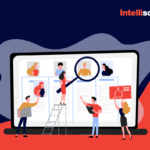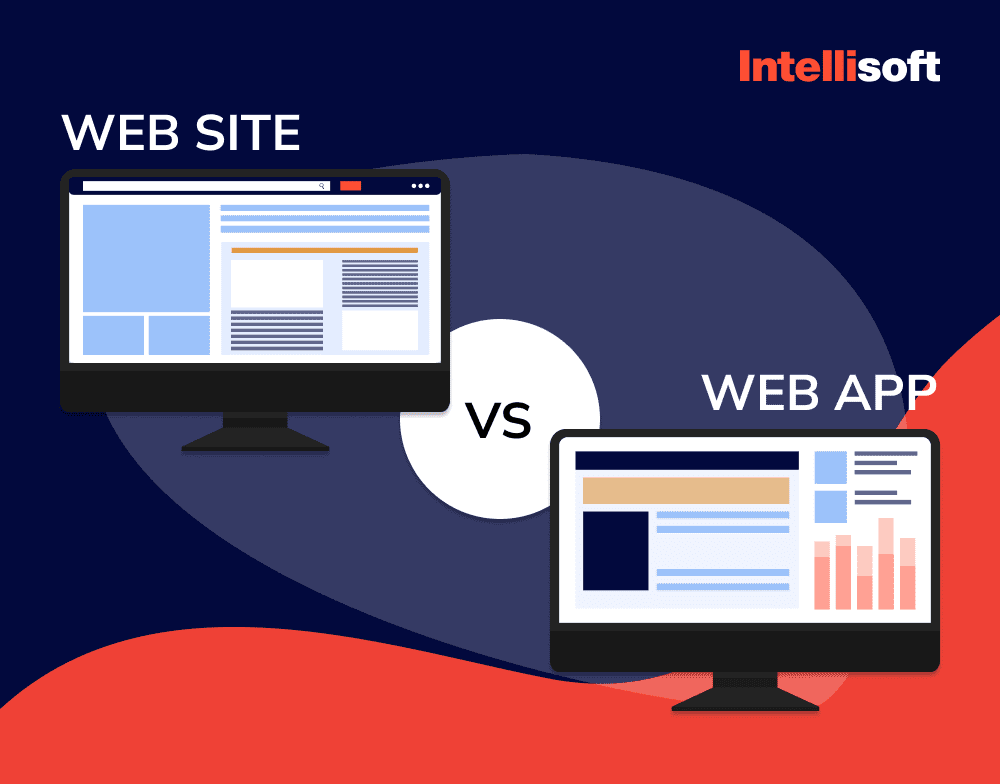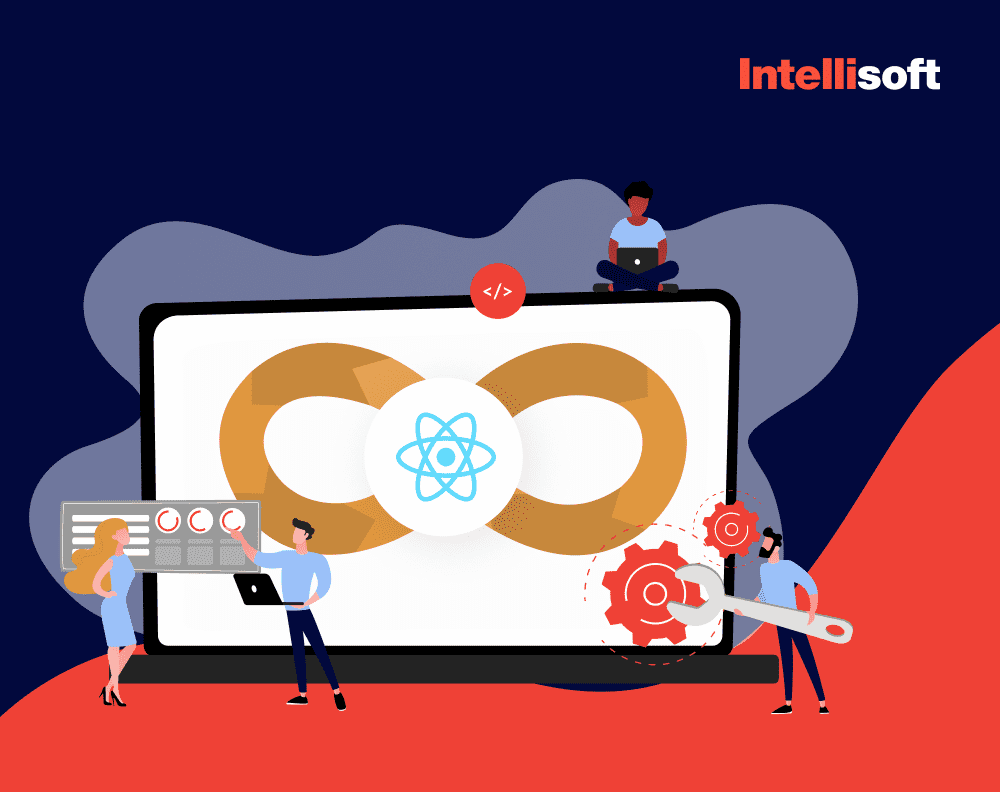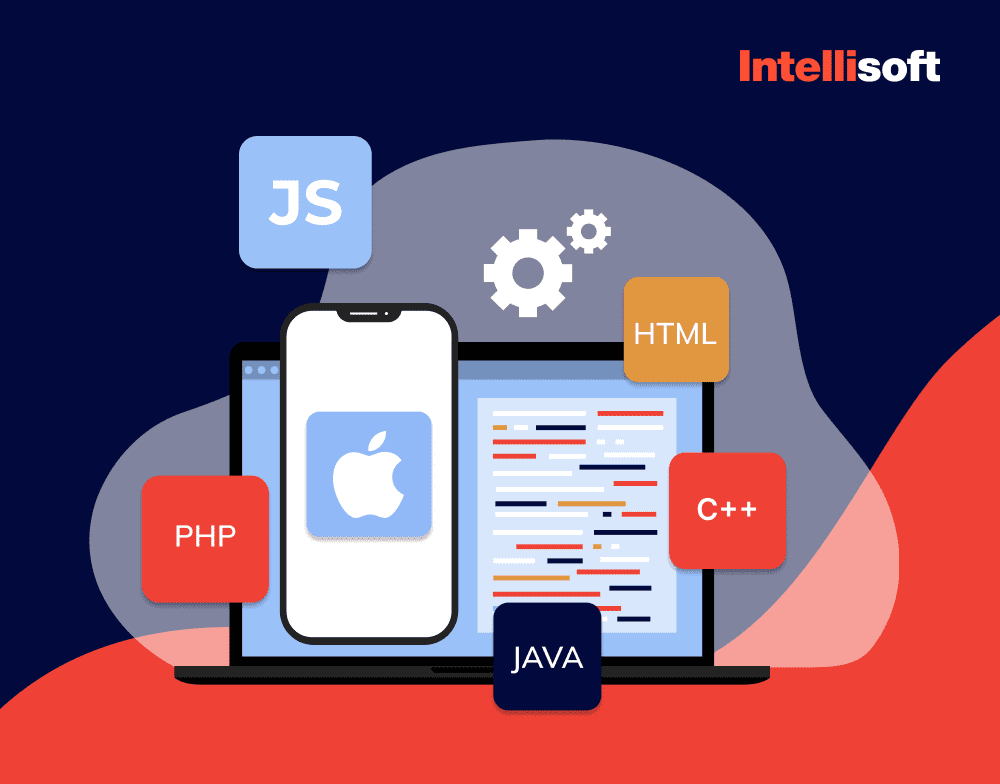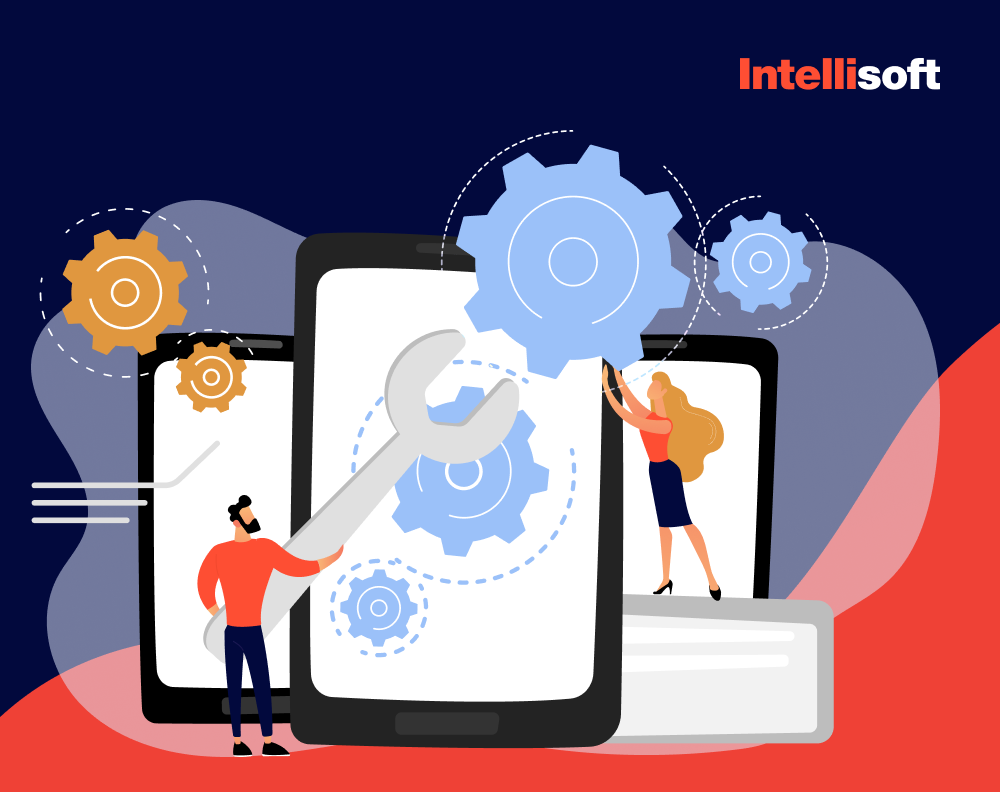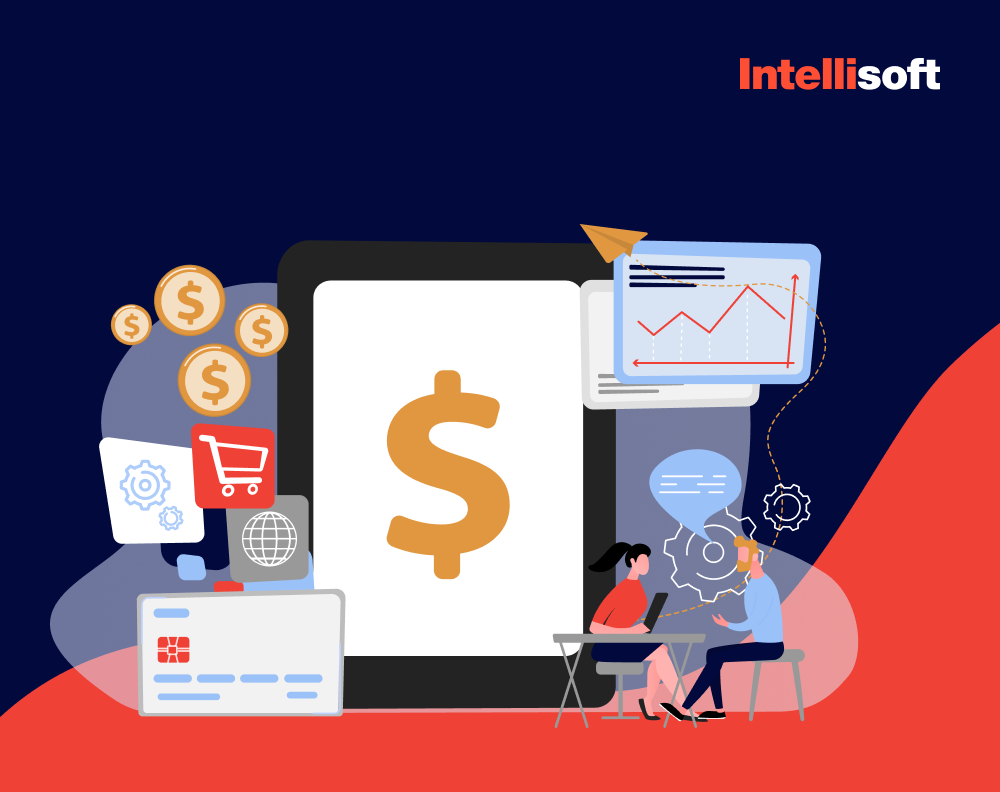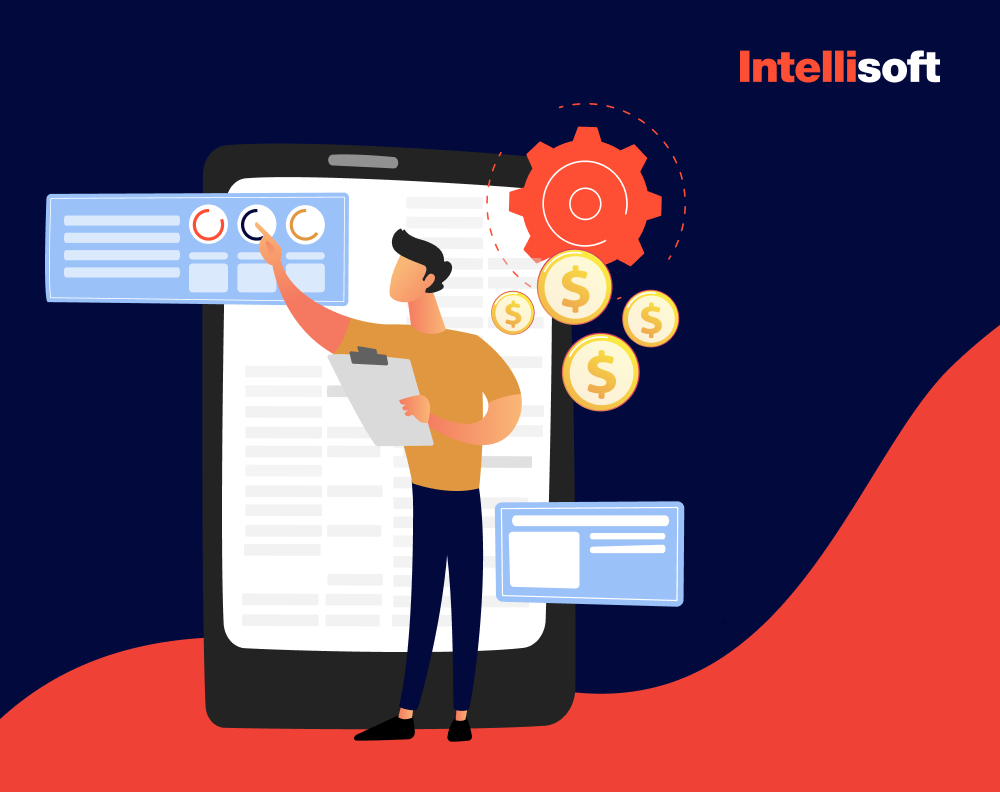iOS app users spend almost twice as much on the Apple App Store as Android users spend on the Google Play Store. In 2021, the Apple App Store earned over $85 billion, and Google Play just under $48 billion. Some may say that because Apple device owners are more solvent, an iOS app can bring in more profits. In fact, it is also because the Apple Store has fewer free apps.
Launching such a tech project as an iOS app has many benefits, but you should be ready to follow the instructions carefully step-by-step if you want to succeed.
Now, let’s answer the question, “how to make an iOS app?”

If you want to attract new customers and make the buying process more convenient, the IntelliSoft team offers mobile app development team extension services that will take your business to the next level. Consider the following steps to let us know when you may need professional help.
Related readings:
- From Idea to Prototype: Build a Mobile App from Scratch
- 20 Main Trends in the Development of Mobile Applications in 2023
- What Is Cross-Platform App And Why to Choose It?
- Steps to Develop a Successful Mobile App for Android
- How to Make a Cross-Platform App That Thrives: A Step-by-Step Guide
Table of Contents
Step 1. Initial Preparations
The first thing one needs to do before hiring the iOS product development team is to shape up the business idea and create a user experience for every feature. If you want to build an iOS app, start with the user story. You need to determine what and for whom you are implementing your idea. At this stage, it is critical to work through all possible scenarios to avoid unpleasant surprises at later development stages.
Behind each item on your to-do list is a huge iceberg of functionality. Try to fragment and make your tasks more specific. Huge expectations are best divided into several stages (releases).
Once the user story is compiled, design and planning begin. At this stage, we use prototypes to show how navigation will occur.
When designing a mobile app for Android and iOS, the good idea is to use hydlines. In common sense, a hydline is a document that the company issues. It allows designers and developers to understand how the app and the user should interact. The buttons should be round for iOS and square for Windows Phone. However, we also use internal guidelines for developers. Thus, the result of the designer’s work most often consists of layouts, hydelines, and sliced graphics.
Layouts are best served relinked when you need to build an iOS app, so the logic of transitions is clear. Hydelines contain information about indents, dimensions, visual effects, animation mechanics, etc. This step can be skipped if your project has one designer and one iOS developer working next to each other. The third part of the result – the slicing of graphics – should contain the minimum necessary graphic resources (we care about the software weight) and versions for different screen resolutions. For instance, most often, the team draws for retina and xhdpi screens. Next comes the preparation for non-retina and mdpi by automated means (if their use is allowed). Most often it is necessary to prepare the hdpi-resources by hand.
Step 2. Hiring the Dev Team To Build An iOS App
Now, it is time to quote different software development firms to create an iOS app. One can hire an in-house team for developing iOS applications, but it will cost more compared with hiring outsourced mobile app developers. It also takes less time to staff such a dedicated team compared with hiring in-house specialists and paying taxes and salaries.
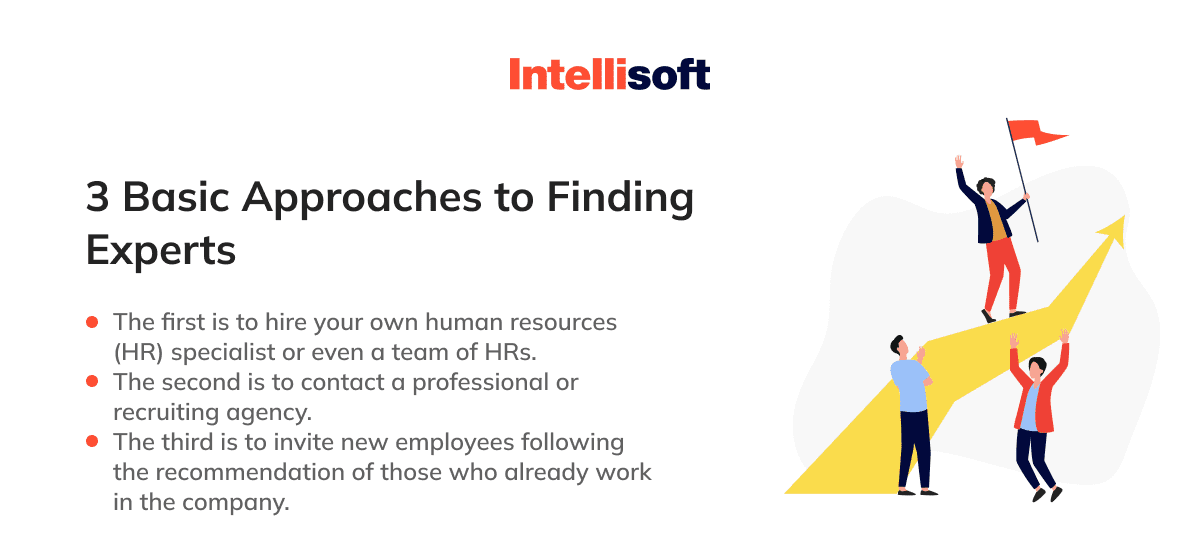
In the early stages it is better to combine recommendations with a recruitment agency. When the team shows stable growth, it is time to hire an HR expert instead of external specialists. Your own HR in the team always understands your requirements better, and also can plan the search of new specialists for several months ahead.
Know Your Requirements!
You should share your vision clearly with the future development team. Before hiring an app development team, you need to understand what specific technologies your solution should be developed on. This will determine the technical expertise of the programmers you need.
At this stage, you may need to discuss your specific requirements with an experienced software developer or development company. For iOS game development, for instance, you may need developers with extensive experience with such engines as Unity and Unreal, and relevant languages for iOS development, like Swift.
Find An App Development Team
First, decide whether it should be an onshore, nearshore, or offshore team. Decide on the composition of the team. Look at each participant’s portfolio: what projects they’ve worked on, what responsibilities they’ve had, etc. Also:
- Look at the entire company’s portfolio. See if there are any major projects and find out what their attendance is.
- Find out exactly how the company handles the support of their products. What if you suddenly start having problems with loads? How would they solve them?
In most cases, you will be able to evaluate the level of functionality and usability of already completed projects, as well as their programming and design skills.
The agency’s portfolio may include projects that satisfy you by the level of your requirements and expectations. Moreover, you will learn more about the company’s experience in a particular field.
In addition, you can visit company accounts on specialized platforms such as GitHub, and Behance.
Study Feedback & Reviews
The best way to learn about working with the IT team is to read reviews from previous clients. To do so, visit the Clutch website or its analogy. This platform specializes in collecting reviews on IT companies around the world.
Through these reviews, you’ll find out if the team has handled projects similar to yours. You can also check if your agency has any awards or certificates. This research will help you determine how popular the team is with peers in the field.
Ask for Contacts of Previous Clients
All companies that have been around for a while have client bases. You can ask for their contacts to talk to them directly. If previous clients are happy with the work done or work in progress, you are in good hands. Otherwise, it is better to look for another team. You will learn more about working with your potential development team through a short interview with previous clients.
Assess the Quality of a Company’s Website
You can learn about a company’s quality standards by examining its online presence. To do this, analyze the company’s social media accounts, website, and content quality (e.g., look through the blog).
Pay attention to the website design, its features, and quality of images. The design of your future team’s website should be up-to-date and to your taste. If a company ignores the latest trends, it is unlikely that it will be able to carry out your project at the proper level.
Choose a Payment Model
For a dedicated team or a project-based working model, you can choose among fixed price or time and material (T&M) paying models. The first one, a.k.a. a fixed bid model, is good for single-time or short-term projects that last not more than several months. Usually, the price cannot be changed. The latter stands for payment for the time and effort spent on the application development for iOS. This type of contract is rather convenient, relatively flexible, and capable of adapting to changes.

Find Outsourcing App Development Specialists
People you may already know. Developing a startup means creating a prototype – you don’t need a large startup team for that. Basically, you only need 2-5 developers. Then you can contact your friends and relatives to see if they have anyone you can think of. Or maybe your nephew has been involved in Android-development for a couple of years, and has already managed to learn something useful.
B2B directories. If you do not have a desire to waste weeks or even months on hiring the team on your own or overloading your single HR, think about hiring an outsourced team of developers. B2B solutions will pick the most suitable experts for you from the pool they are already familiar with.

Freelance websites. There are plenty of sites where you can find programmers eager to work on a cool project, even for a small fee: LinkedIn, upwork.com, StackOverflow Jobs, djinni.co, Clutch, Dribbbl, Fiverr, Behance, Toptal, GeekJob, freelancer.com, etc.
Dev blogs. Most often, posts similar to what you can see in our blog are read by IT experts. Our website unites startups and developers around the globe. You might be reading this blog along with talented engineers right now. So just let us know if you want us to grab them for you.
Let’s say, you agree that you need a team from scratch for creating Apple apps. At the same time, you realize how much nerves, time, and money you’ll save if you turn to a specialized outsourcing company. IntelliSoft is a guru of team extension. We suggest several ways to extend your team.
Choose any convenient form to contact us and let’s get directly to discussing your project’s scope. We need to know your requirements and expectations to choose the top professionals for you. Our professionals conduct interviews and in-depth research to come up with the best solutions for your business.
You can view a portfolio of any specialist we offer at any time. You can communicate with the experts directly. As for onboarding, we take full control over it, so no worries!
You will obtain regular reports on the progress of your project and outcomes. Remember that our specialists can implement all of your ideas, enriching your product or service with brand new features.
Step 3. Prioritize Features for the iOS Project MVP
MVP stands for a minimum viable product. The MVP usually includes only the most basic elements of a mobile app. For example, if we are talking about ordering goods at home, the MVP will include a catalog and an order form. Features such as in-app payment, in-app chat, and push notification support are usually implemented in the following steps.
“Launching an MVP allows you to offer users the first version of your mobile app much earlier than if you were developing all the intended features at once.
Depending on the project, MVP significantly reduces time-to-market – sometimes even up to 10 times!”
Kosta Mitrofanskiy – CEO @ IntelliSoft. A technology expert and entrepreneur with 20+ years of experience in the web & software development business.
Being able to get initial feedback from your users helps you adjust or formulate your application development strategy. For example, it may turn out that you don’t need geolocation or payment gateway integration at all. This saves time, nerves, and money that would have gone into implementing that feature.
After successfully passing the MVP stage, the mobile app continues to develop and acquire functionality. Further development can take place in a variety of formats, with or without frameworks.
Still, the most important thing is to carefully work through the prototype and MVP stages, because it’s longer and more expensive to make changes to the already implemented elements than plan the gradual development of the product and adapt your vision of the mobile app to the needs of real users at each stage.
Step 4. Development
To better understand the management of development processes, you need to know not only the scheme by which the development team is built, but also who is who. Here’s a classic set:
- Product owner. No comments!:)
- Project manager (PM). Project managers are intermediaries in software development. They connect the team, monitor deadlines, and periodically check to see if the workflow has been disrupted.
- UI/UX designers. This part of the team gets involved in the early stages of software development and makes sure everything is simple and straightforward. They are assisted by UI/UX copywriters.
- QA engineers. Quality assurance is about ensuring the quality of the product. Testers look for and remove bugs from the beginning, and make sure the solution works well at every stage of the iPhone app development process.
- Developers. They are responsible for the tasks involved in software development. These guys create apps based on tech requirements and assemble the architecture using tools for iOS development. Usually, you need several developers for one project: front-end, back-end, and full-stack developers.
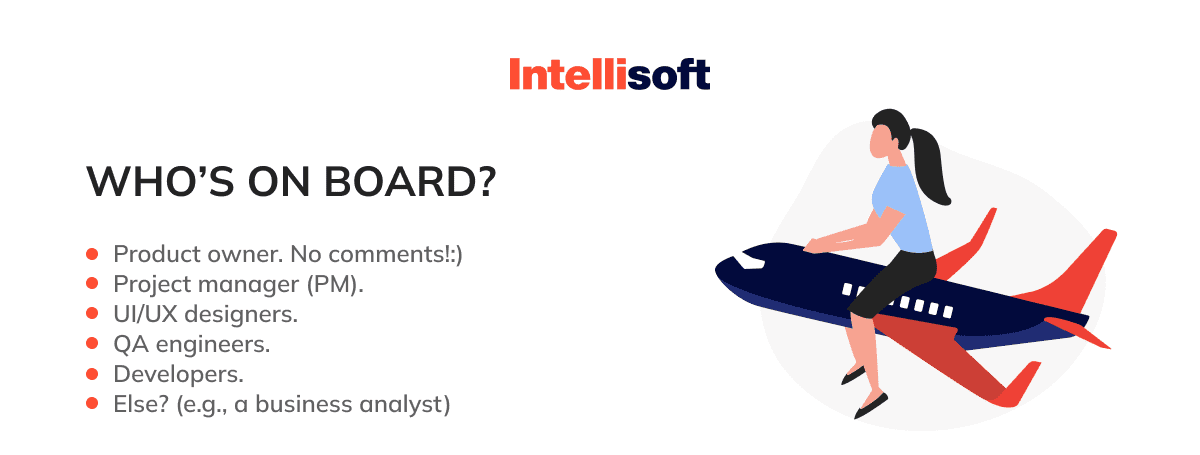
When choosing the optimal programming tech stack for your iOS project, several factors matter. The type of project is the determining stack factor. For example, if you want to create a complex iOS app with high performance and UI implementation, it is better to choose native development. In this case, Swift will be the best programming language to create a mobile app. Also, consider the following stages when you start developing iOS apps:
- Idea validation. Relevant for startups that only want to test the product idea. At this stage, it is important to involve potential users to better understand the needs of the target audience. In this case, Flutter can be considered, as it is cost-effective and allows code reuse on many platforms. This leads to a wide platform reach and fast app delivery.
- Time-to-market (TTM). The way companies bring products to market is important for maintaining a competitive advantage. If you need to release a product ASAP, consider a framework or programming language with many ready-made solutions for general development, such as integration with social networks and authentication.
Most Common Tech Stacks for iOS App Development
So, what is the most suitable iOS development tool for your project? Several languages and frameworks should be considered.

- Objective-C
Objective-C is a general-purpose language developed on top of the C programming language by adding features of the Small Talk language, making it an object-oriented language. Objective-C is used by Apple Corporation and has access to most of the standard libraries. An app developed with this technology will have a nice smooth interface and run quickly.
- Swift
Swift is a more functional language, which allows you to avoid bugs in the code easily. In addition, applications in this language will be more productive, and Apple now supports this technology as well. iOS swift development offers efficient features with minimal code that can be easily maintained.
- Flutter
Flutter is a cross-platform development technology created by Google. Apps created with this framework will work on both Android and iOS. Flutter is flexible and widely used at YuSMP Group, but it is not always the best choice of cross-platform technology.
Step 5. QA & Testing
Quality assurance testing (QA) ensures that you get stable, safe, and functional software. It is ideal if several tests are performed. User experience testing will verify the application through its design. Functional testing is aimed at checking all the app functions. Performance testing will help assess the loading speed, as well as check if there are memory leaks or unwarranted battery consumption. Security testing looks for vulnerabilities that could put user data at risk. Device testing ensures the application functions on different devices.
Many modern apps are tested in an automated mode that allows you to simulate multiplayer and load testing scenarios. We recommend leveraging all options to minimize the likelihood of errors. You have created the first version of the application with limited features, and only basic functions. It’s time to evaluate and present the remaining features that were set aside in the original version. You’ll find out whether these features are relevant through analytics and feedback.
Step 6. MVP Launch
Deploying an application is a series of actions that make the product ready to use. The application must be downloaded from the App Store or Google Play. Immediately after downloading, the review process will begin. Google will take a few hours to review and approve the app. As for Apple, because of the strict verification process, the procedure takes about a week.
If app development involves working with the database and server part, they will have to be deployed separately. You can try to do the deployment yourself or use the outsourcing services.
The time it takes to create an app depends on its complexity: the more complex it is, the longer it will take to develop. On average, it takes 16-20 weeks to develop.
The App Store and Google Play have millions of apps for any taste, but not all of them are easy to find. If an app has a low rating and hasn’t become an editorial choice, it will be extremely difficult to find through organic search. A thoughtful marketing strategy will help your audience discover the app through other channels such as social networks.
You can do the marketing yourself or turn to specialists. When choosing a marketing agency, make sure the marketers have a clear understanding of app promotion. Perhaps, there is a team of experts at an agency that specializes in mobile development. In this case, it is the best option, because they know the world of mobile products from the inside out.
In any case, should it be app maintenance, tech support, or promotion, IntelliSoft can take care of the project after the MVP launch and implement further features. Our team can also help with marketing.
Conclusion: Making Money with iOS Mobile App
Apple users are willing to pay for quality products: this applies to both devices and their software. That said, iOS owners do in-app purchases many times more willingly than Android users. Don’t hesitate while developing an app that has a paid subscription or in-app purchases: if it solves the user’s problem, the user is not left in debt. Besides, if you compare the prices in online app stores, you will find that some solutions in the App Store are offered at higher prices than in Google Play.
Applications on the App Store are protected against piracy. If someone wants to steal your project from the store, they will have to sacrifice their device warranty. Therefore, it is either impossible to install a cracked app downloaded from the Internet, or it will cost much more than a subscription.
Anyway, if you follow the recommendations in our post, you have all chances to succeed. To raise those chances, you may need pro help.
If you realize that it’s going to be difficult to develop a stunning iOS app by yourself, know that IntelliSoft team offers affordable prices for iOS software turnkey development (or we can assist with adding new features or updating the existing ones). Contact our specialists for more details!
